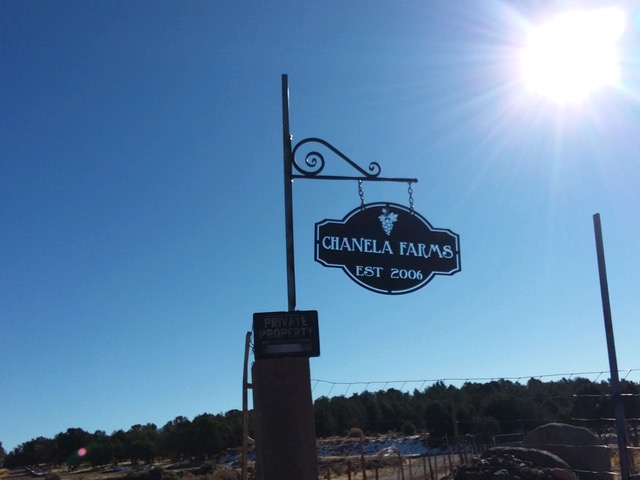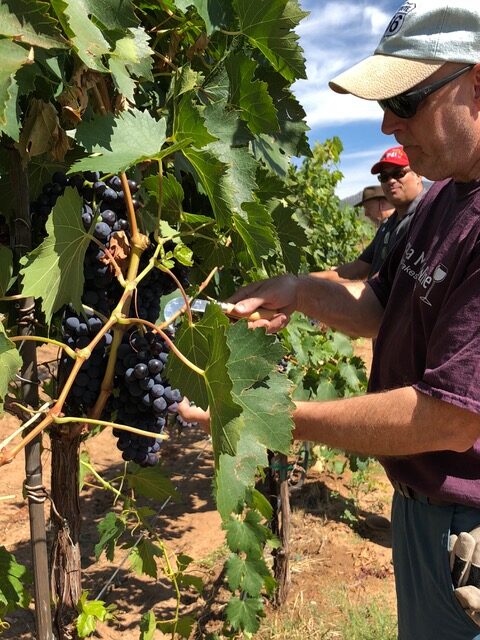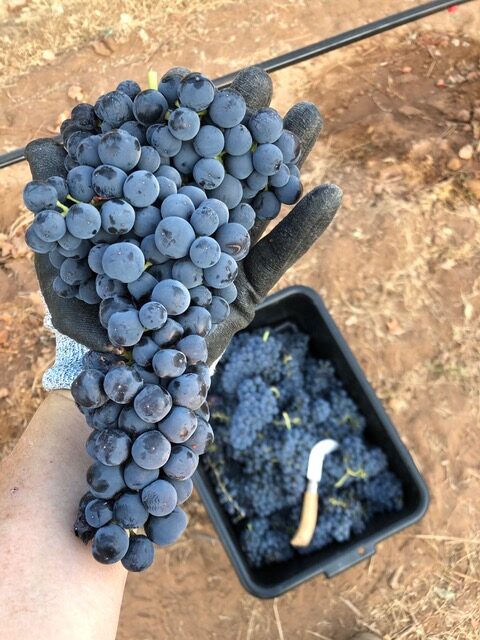Our vineyards are located about 15 miles north of St. George, Utah on the southeastern slopes of Pine Valley Mountain. The main vineyard slopes gently from the NE at 5,034’ above sea level to the SW, gradually sloping to 5,000’. Our second vineyard has a similar slope but starts a bit higher at 5,061’ above sea level. While there are other vineyards located in Dammeron Valley to our west, and Apple Valley and Leeds to our east, ours are the highest elevation vineyards in Utah.
The daily difference between day and night temperatures (called diurnal) is created as the sun warms the vineyard during the day then, as the sun sets, is cooled by the steady descent of air down the southeast slope of Pine Valley Mountain. The daily average diurnal is as high as 16.5 °C (30 °F), and these temperature variations are of particular importance in our vineyard and play a key role in its success. In grapes, this variation has the effect of producing higher acid and sugar content. This is because the grapes’ exposure to sunlight increases the ripening qualities allowing for more sugar production, while the drop in temperature at night preserves the balance of natural acids in the grapes. The elevations and the associated UV exposure also cause the grapes to grow thick skins to protect the fruit which, in turn, creates wines of intense color and robust tannins. The warm climate means the grapes want to get sweet quickly, sometimes before the grapes reach a phenolic ripeness needed for great taste. For this reason, we like the higher elevation offered by our location. It helps keep the temperatures cooler than the surrounding valley floor, and it also offers significantly greater cooling in the evening hours.
Despite the cooler temperatures resulting from elevation, it can still get quite warm, and the UV effects of the sun are greater than at lower altitudes. For this reason, the vineyard has to be carefully managed to encourage as much hang-time as possible through irrigation and canopy management. We are careful to shade the grapes correctly, allowing us to manage sugar development and pace it with phenolic ripeness. Our trellis system uses a vertical shoot position (VSP) style, but because we get warm daytime temperatures we are careful not to remove leaves on the afternoon side of the canopy (west) to prevent sunburn. In our case, canopy management on a VSP is practiced only on the morning side (east) of the canopy. The soils in the vineyard are eroded from 20-million-year old granitic rock, brought here from Pine Valley Mountain. The vineyard itself sits on an apron of sediment which geologist call an alluvial fan. Mixed with this ancient granite is a healthy portion of decomposed lava rock that is visible in the lava hills to the south of the vineyard. In addition, there is a lot of sandstone that has been eroded away from what is commonly referred to as the Navajo sandstone layer, a 2,000-foot-thick layer of sand brought here a very long time ago from the Appalachian Mountains in the eastern US.
The soil, elevation and location all contribute to what is called terroir, a French term that literally translated means: earth, soil, land or place. In viticulture, the word has more commonly come to refer to the set of all the environmental factors that affect the grapes, including its unique environment, farming practices and the vines specific habitat. Collectively, these characteristics are said to have a unique character or “terroir”. What you’ll notice about the terroir coming through in our grapes is a rich, dark fruit with hints of purple sage, cedar and mineral and dust. The vineyards are planted in a total of 12 different varietals that include Chardonnay, Sémillion and Pinot Grigio in the white varietals and Zinfandel, Sangiovese, Cabernet Sauvignon, Merlot, Tempranillo, Malbec, Petite Sirah, Pinot Noir and Petit Verdot in the red varietals. Each varietal offers its own unique expression of the terroir of this land, an expression unlike any other. We encourage you to take some time to relax and enjoy a bottle of Chanela Vineyards wine and let it convince your palate of the beauty of this location.





